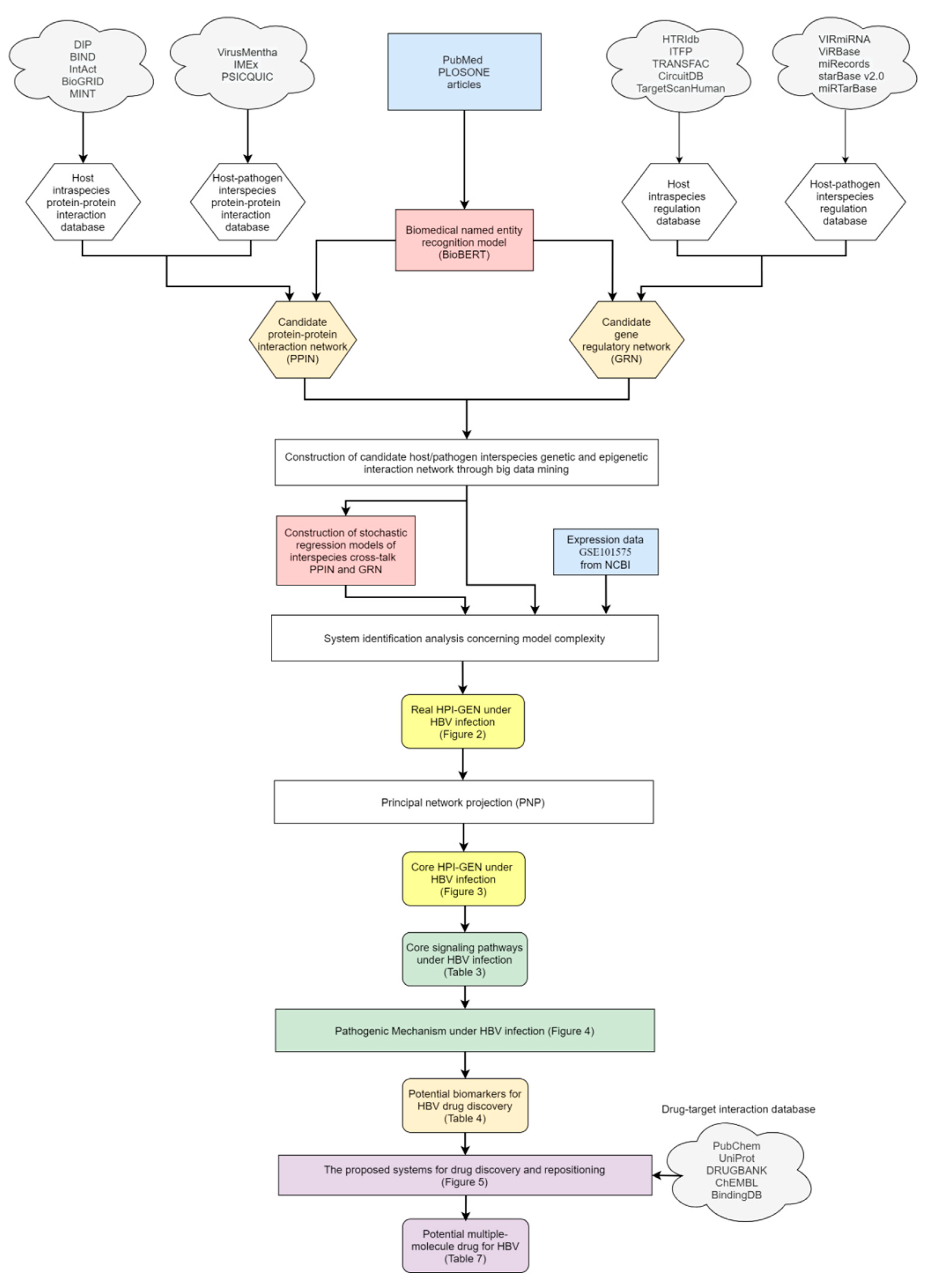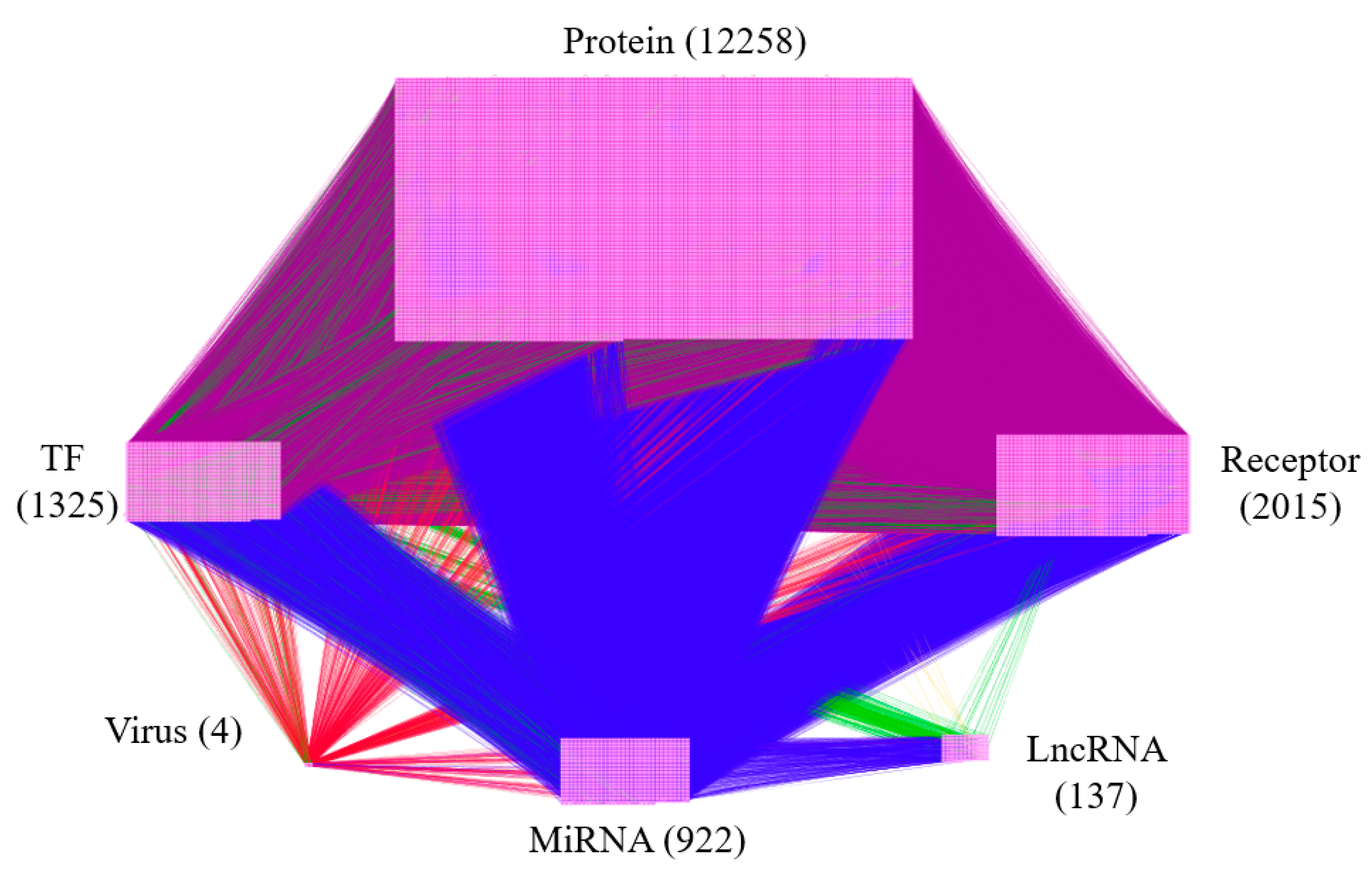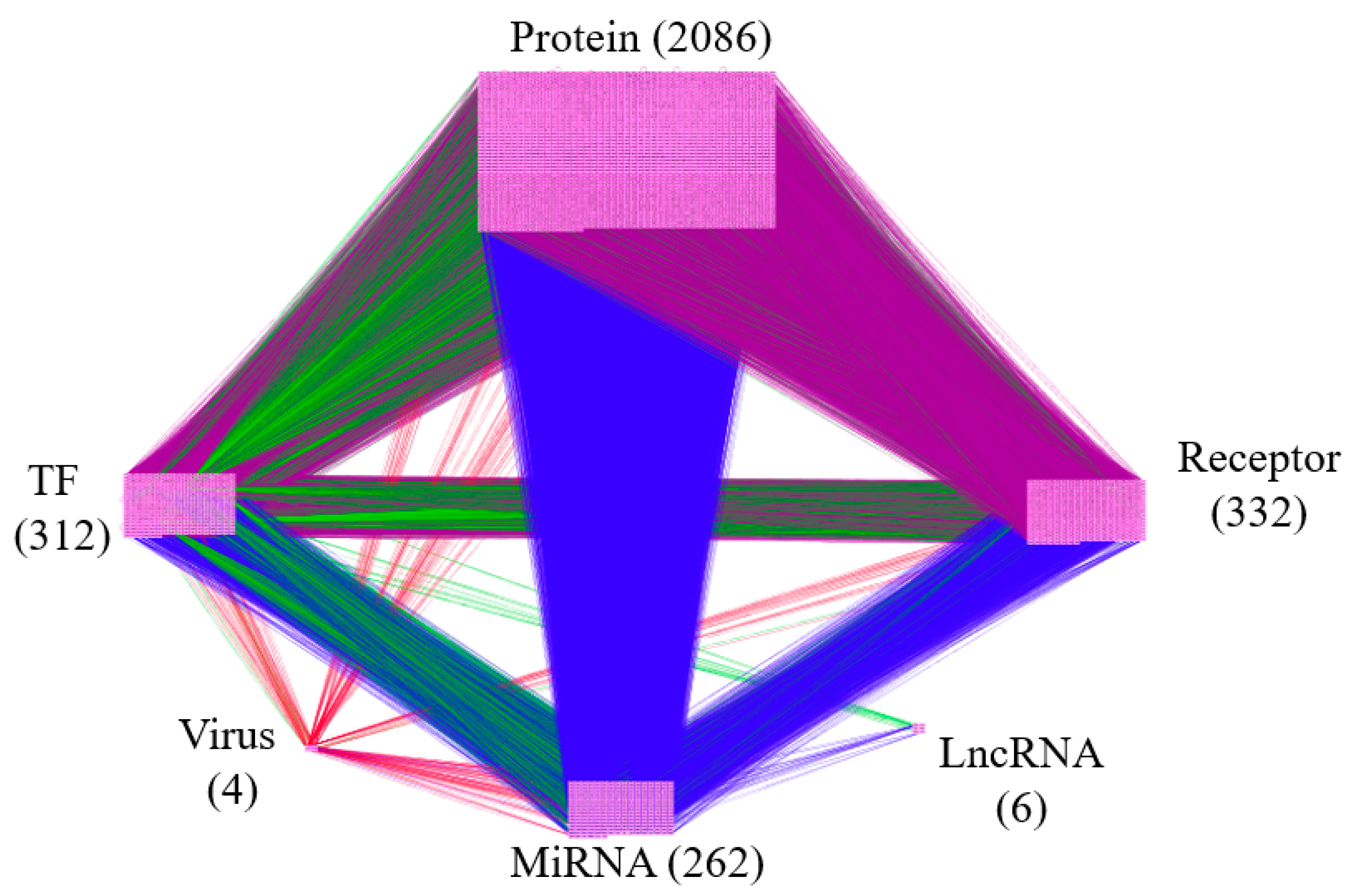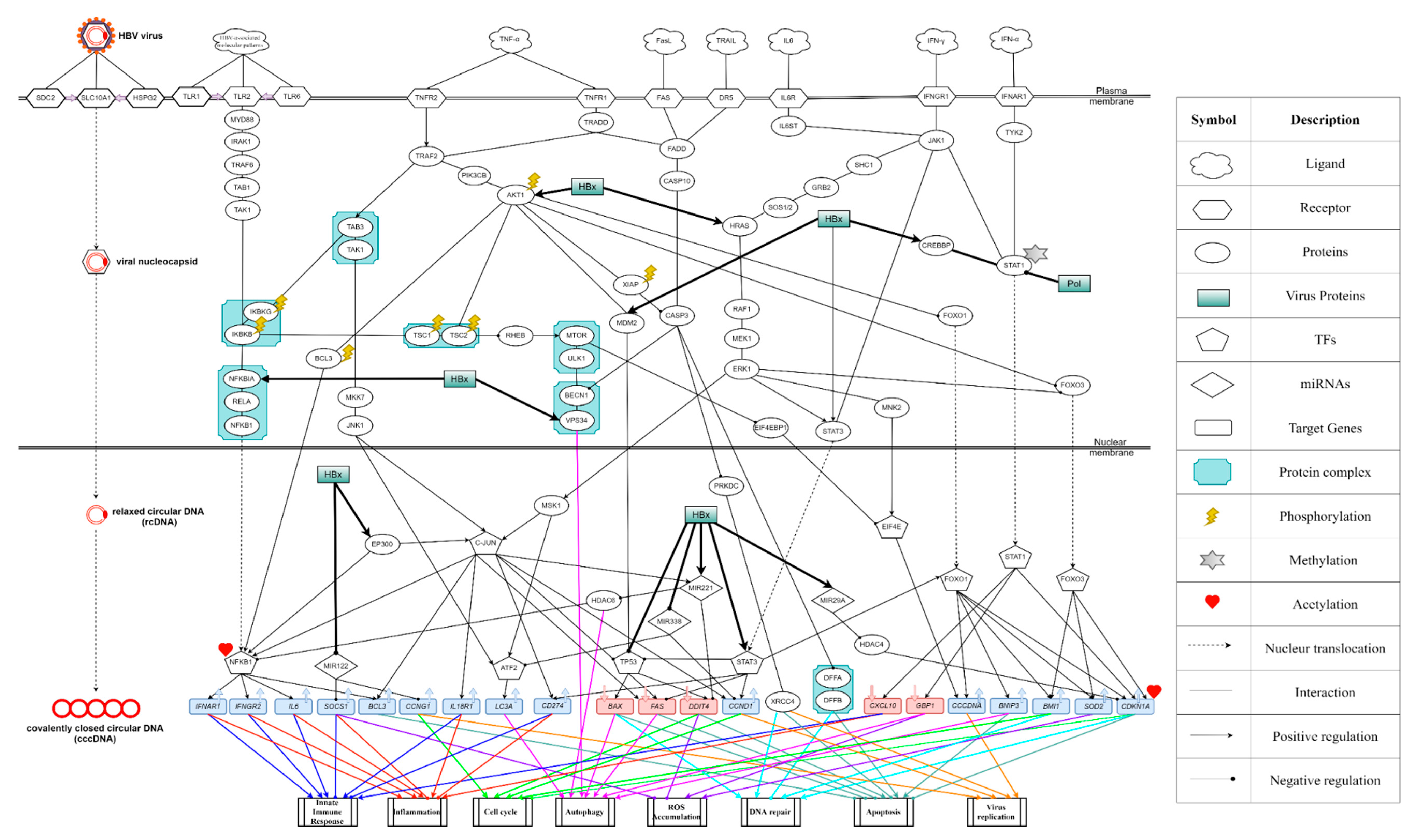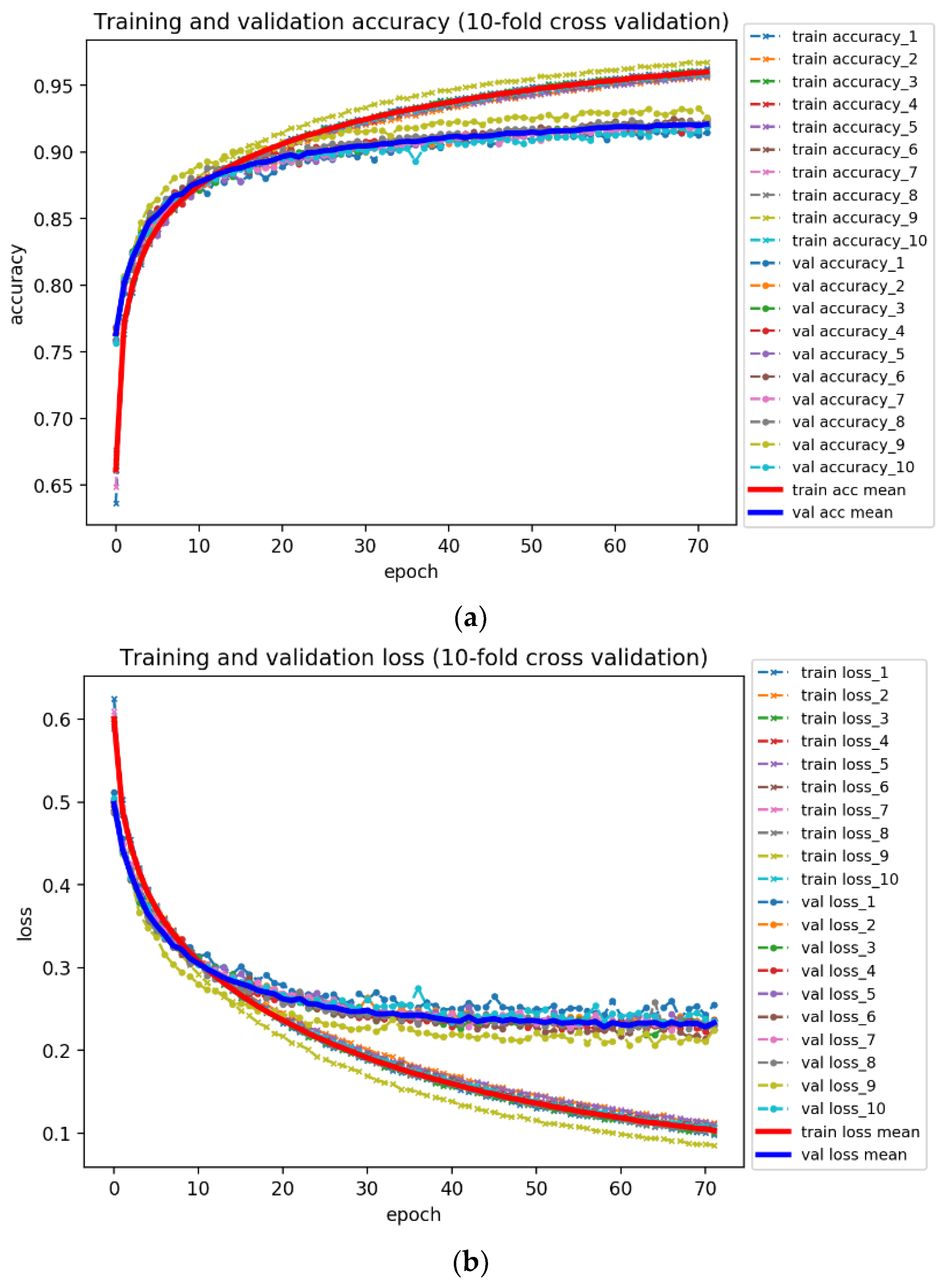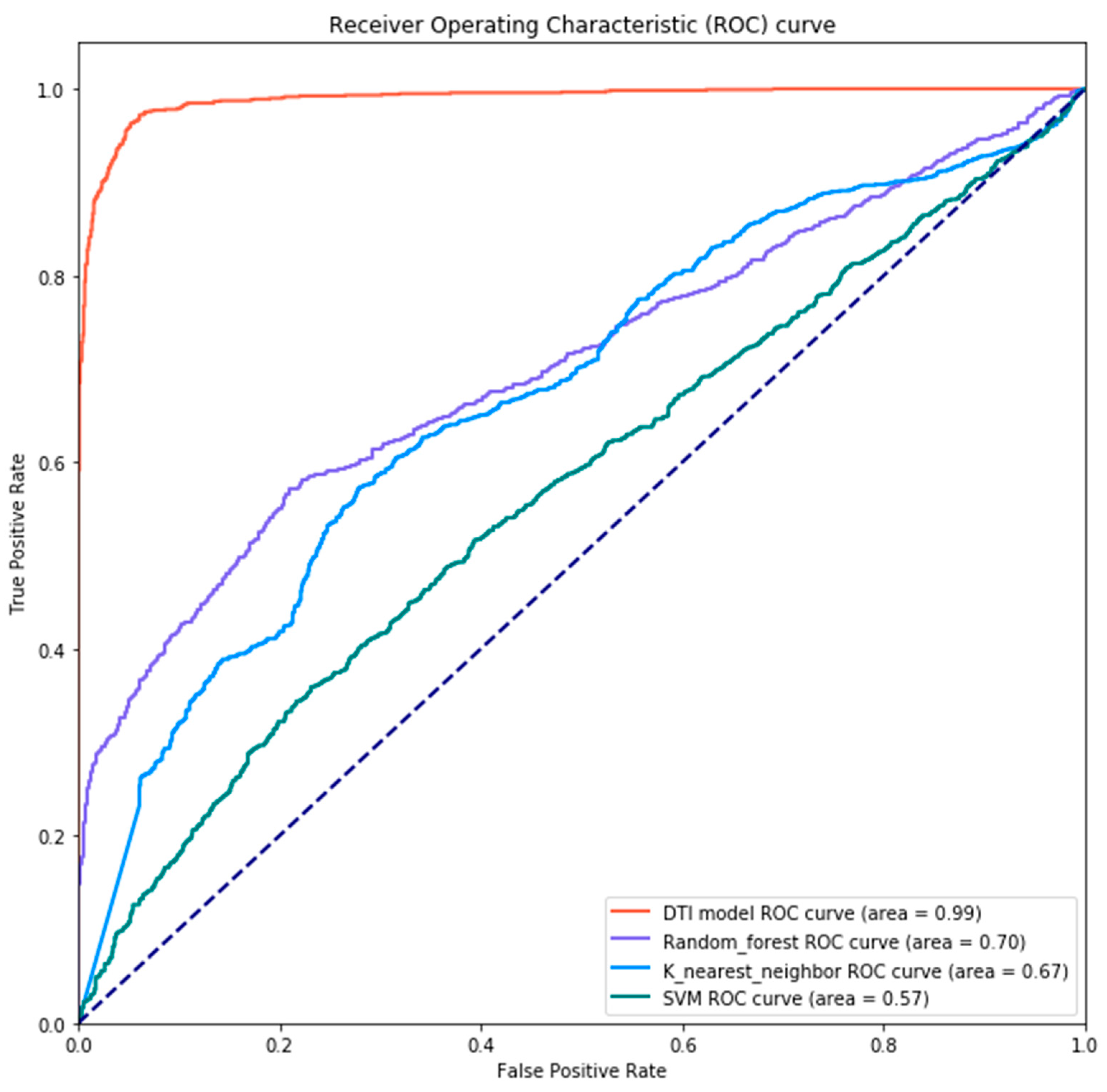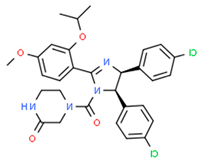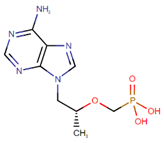2.3. Text Mining of Human and Pathogen Protein Interactions
To reinforce the comprehension of the interaction relationships between host and pathogen, BioBERT (Bidirectional Encoder Representations from Transformer for Biomedical Text Mining) [
35,
36], an up-to-date BioNER (Biomedical Named Entity Recognition) approach is employed on the PubMed database to analyze binary interactions between host and pathogen. BioNER is a computerized procedure of identifying biomedical named entities such as genes, protein complexes, diseases, and chemicals in texts referring to information retrieval and data extraction. Amongst all the BioNER application, BioBERT, which has achieved state-of-the-art performance in terms of precision, is efficaciously utilized in biomedical text mining applications to address data.
In brief, we scraped and collected 26,732 existing PubMed articles associated with Hepatitis B Virus and Homo sapiens within 20 years and transformed it into XML format. Nonetheless, on account of Pubmed’s property, the full texts from most articles in PMC aren’t publicly accessible so that looking forward to automatically download integrated content is unrealistic. Consequently, we additionally crawled 2831 articles from PLOS ONE to strengthen our network complexity. Then, BioBERT model was exerted to discern known entities and identify the types of overlapping entities among each sentence separated from the relevant content with periods in the corpus.
In order to facilitate analysis and reconfirmation, we also gathered the synonym names of both host and pathogen proteins (compiled from BioThesaurus database [
37]) to prevent omission of vital interactions owing to protein names mismatch. Afterwards, in each sentence, we extracted all present proteins and identified the correlations by determining the human proteins under the circumstance that Hepatitis B Virus proteins had existed. To abate computational complexity, in conformity with the subsequent system identification processing requirement, the verb recognition and identification were left out of account and binary interactions were built. For instance, providing that “HBx” and “BCL2” were simultaneously identified in the same sentence, we then set the corresponding value to 1 and so forth, vice versa to 0.
Furthermore, to verify that authentic interaction relationships derived from the statistical analysis of sentences, we scrutinized entire extracted entities and completed the construction of ultimate host and pathogen interaction-relationships matrix.
2.4. Dynamic Models of Candidate HPI-GEN for Human Cells and HBV During the Infection
Candidate HPI-GEN, constructed via big data mining techniques, is the epitome of an intricate network comprised of protein interactions and gene regulations between host and pathogen during HBV infection. As inevitable false-positive information extraction might incur system distraction from genuine consequence and discrepancy during the pathway analysis process, dynamic models were built to carry out systematic identification approach by two-side time-profile HBV infection RNA-seq data to prune false-positives in candidate HPI-GEN.
Protein abundances mirror a dynamic balance among a series of linked processes spanning the transcription, processing, and degradation of mRNAs to the translation, modification, and breakdown of the proteins themselves necessary for cellular protein production and maintenance [
38]. As a consequence, for the protein interactive model of PPI pre-network in candidate HPI-GEN, the dynamic interaction model of the
ith host protein can be described by the following equation:
where
and
indicate the expression levels of the
ith host protein, the
nth host protein, the
ith host gene, and the
vth pathogen protein at time
t, respectively;
and
denote the interactive ability between the
ith host protein and
nth host protein and between the
ith host protein and
vth pathogen protein, respectively;
signify the number of host proteins and pathogen proteins interacting with the
ith host protein; and
typifies the total number of the human proteins in candidate PPIN.
and
indicate the translation rate from the corresponding mRNA, the degradation rate, and the basal expression level of the
ith host protein, respectively; the basal level denotes the interactions with unknown factors, such as acetylation, methylation, and ubiquitination; and
represents the stochastic noise of the
ith host protein at time
t. Note that the intraspecies and interspecies biological mechanism of human proteins in candidate PPIN are represented in Equation (1) as the form of
and
, respectively.
Now that the interactions between the host and pathogen proteins are mutual and their biological characteristics involved in PPIs are similar, the dynamic PPIN of the
pathogen protein in candidate HPI-GEN can be described by the analogous equation as follows:
where
and
indicate the expression levels of the
pathogen protein, the
nth host protein, the
pathogen gene, and the
vth pathogen protein at time
t, respectively;
and
denote the interactive ability between the
pathogen protein and
nth host protein and between the
pathogen protein and
vth pathogen protein, respectively;
and
signify the number of host proteins and pathogen proteins interacting with the
pathogen protein; and
typifies the total number of the pathogen proteins in candidate PPIN.
and
indicate the translation rate from the corresponding mRNA, the degradation rate, and the basal expression level of the
pathogen protein, respectively; the basal level
denotes the interactions with unknown factors such as acetylation and ubiquitination; and
represents the stochastic noise of the
pathogen protein at time
t. Similarly, the intraspecies and interspecies biological mechanism of pathogen proteins in candidate PPIN are represented in Equation (2) as the form of
and
, respectively.
For the GRN of host genes in the candidate HPI-GEN, the dynamic regulatory model of the
jth host gene can be described as follows:
where
and
indicate the expression levels of the
jth host gene, the
host TF, the
host microRNA, and the
host lncRNA at time
t, respectively;
and
represent the regulation ability of the
host TF, the
host microRNA, and the
host lncRNA on the
jth host gene, respectively;
and
denote the number of host TFs, host miRNAs, and host lncRNAs, respectively, which regulate the expression level of the
jth host gene;
indicates the total amount of genes in GRN;
and
indicate the degradation rate and the expression basal level of the
jth host gene, respectively; and
denotes the stochastic noise due to modeling residue at time t. The basal level
denotes the unknown regulations such as methylation. Note that since microRNAs silence gene expression by binding to target mRNAs [
39], repression ability
in candidate GRN model should be constrained negative. Likewise,
degradation rate should be restricted non-positive due to the depression regulation of mRNA. Furthermore, though supporting evidence comes from numerous research showing that HBV proteins play a vital role in the regulation of viral and host gene expression, different from other viruses such as HIV, whose viral protein directly binds to nucleic acids [
40], HBV proteins are thought to affect host gene expression through transregulation, e.g., transactivation and transrepression [
41,
42,
43,
44]. Thus, it seems tenable to exclude the regulations between pathogen proteins and host gene in the Equation (3).
In the same way, for the GRN of pathogen genes in the candidate HPI-GEN, the dynamic regulatory model of the
pathogen gene can be described as follows:
where
and
indicate the expression levels of the
pathogen gene, the
host TF, the
host microRNA, and the
host lncRNA at time t, respectively;
and
represent the regulation ability of the
host TF, the
host microRNA, and the
host lncRNA on the
pathogen, respectively;
and
denote the number of host TFs, host miRNAs, and host lncRNAs, respectively, which regulate the expression level of the
pathogen;
indicates the total amount of pathogen genes in GRN;
and
indicate the degradation rate and the expression basal level of the
pathogen, respectively; and
denotes the stochastic noise due to modeling residue at time
t. It is worth noting that there is a consensus on the opinion about the indispensability of host protein synthesis machinery for pathogen protein production and gene transcription [
45,
46]. Walsh et al. [
47] even suggested that viruses are fully reliant on the translation machinery of their host cells to produce the polypeptides that are essential for viral replication. As a result, only gene regulation conducted by host transcription factors
instead of pathogen proteins
is included in Equation (4).
Since the expression of the
host miRNA
and the
th host
in Equation (3) at time
t might also be regulated by other regulators, the
miRNA can be described by the following stochastic dynamic regulatory equation:
where
and
indicate the expression levels of the
host gene, the
host TF, the
host miRNA and the
host lncRNA at time
t, respectively;
and
represent the regulation ability of the
host TF, the
host microRNA and the
host lncRNA on the
host miRNA, respectively;
and
denote the number of host TFs, host miRNAs and host lncRNAs, respectively, which regulate the expression level of the
host miRNA;
indicates the total number of miRNAs in GRN;
and
indicate the degradation rate and the expression basal level of the
host miRNA, respectively; and
denotes the stochastic noise due to modeling residue at time
t.
Along the same line, the dynamic regulatory model of the host lncRNA in candidate GEIN can be described by the following dynamic equation:
where
and
indicate the expression levels of the
host lncRNA, the
host TF, the
host microRNA and the
host lncRNA at time t, respectively;
and
represent the regulation ability of the
host TF, the
host microRNA and the
host lncRNA on the
host lncRNA, respectively;
and
denote the number of host TFs, host miRNAs and host lncRNAs, respectively, which regulate the expression level of the
host lncRNA;
indicates the total number of lncRNA in GRN;
and
indicate the degradation rate and the expression basal level of the
host lncRNA, respectively; and
denotes the stochastic noise due to modeling residue at time
t.
2.5. Parameter Estimation of the Dynamic Models of Candidate HPI-GEN by System Identification Approach
In order to identify real HPI-GEN, the accurate model parameters training process by executing a system identification approach to the candidate HPI-GEN after the construction of dynamic model Equations (1)–(6) is requisite. Consequently, the stochastic Equations (1) and (2), which depict the relation of protein interactions of the ith host and qth pathogen protein, can be converted into the linear regression forms as below, respectively:
The
qth host protein:
where
and
represent the regression vectors that can be obtained from the expression data and
and
are the unknown parameter vectors to be estimated for the
host protein,
pathogen protein in host PPIN, respectively.
Thence, the Equations (7) and (8) of the ith host and qth pathogen protein can further be augmented for and time points as the following forms, respectively:
The
ith host protein:
the Equation (9) can also be simply represented as
The
qth host protein:
the Equation (11) can also be simply represented as
After a succession of equation transformation procedure in advance, the parameters in vectors
and
of Equations (10) and (12) can be estimated by individually employing the following constrained least-squares estimation problems,
parameters estimation:
parameters estimation:
Subsequently, we can acquire the interaction parameters in PPIN Equations (1) and (2) individually by resolving the least-squares problems in (13) and (14) with the help of the function lsqlin in MATLAB optimization toolbox and simultaneously ensure the protein translation rate and to be a non-negative value and the protein degradation rate and to be a non-positive value; that is to say and .
In the same manner, the dynamic Equations (3)–(6) which depict the relationship of gene regulations for the jth host gene, uth pathogen gene, host miRNA, and host lncRNA can be rewritten into the linear regression forms below, respectively:
The
host lncRNA:
where
and
represent the regression vectors that can be obtained from the expression data and
and
are the unknown parameter vectors to be estimated for the
host gene,
pathogen gene,
host miRNA, and
host lncRNA in host GRN, respectively.
Then, Equations (15)–(18) of the jth host gene, uth pathogen gene, host miRNA, and host lncRNA can be further augmented for and time points as the following forms, respectively:
The
jth host gene:
the Equation (19) can also be simply represented as:
The
uth pathogen gene:
the Equation (21) can also be simply represented as:
The
host miRNA:
the Equation (23) can also be simply represented as:
The
host lncRNA:
the Equation (25) can also be simply represented as:
After a succession of equation transformation procedure in advance, the parameters in vectors
and
of Equations (20), (22), (24) and (26) can be estimated by individually employing the following constrained least-square estimation problem,
Through applying the function in MATLAB optimization toolbox to solve the constrained least-squares estimation problem in (27)–(30), we could obtain optimal regulatory parameters for GRN Equations in (3)–(6) and concurrently guarantee that the miRNA repression ability and as well as the degradation rate and values corresponding to the jth host gene, the uth pathogen gene, the host miRNA, and the host lncRNA to be non-positive, respectively.
So far, the structure of dynamic regression model construction is complete, yet if we substitute the expression data into the linear model right away, infinite solutions problems will emerge due to the lack of enough data points, in other words, information deficiency in comparison with parameters for evaluation, that is, overfitting. Thus, the cubic spline for extra numbers of time-profile data points interpolation is applied to prevent this trouble (For more details, readers can refer to
Appendix A). Then, with the processed RNA-seq data, the accurate solutions of the constrained least-squares estimation problems in (13)–(14) and (27)–(30) can be attained.
Moreover, since the measurement technology of genome-wide protein expression in HepaRG cells and Hepatitis B Virus during infection hasn’t been realized yet, and supporting evidence comes from research showing that the cellular concentrations of proteins correlate with the abundances of their corresponding mRNAs, which implied that the variance in protein abundance can be explained by that of mRNA [
48,
49,
50,
51] and a correlation coefficient of 48% was also obtained between the mRNA and protein abundances in human liver [
49], i.e., the RNA-seq data of gene expressions can substitute protein expressions and contribute to sufficient information for resolving above constrained least-squares parameter estimation problems in (13) and (14) and (27)–(30). One could retain more information in our previous research [
52].
2.6. Determination of Significant Interaction Pairs
On account of approaching the best combination to constitute the robust HPI-GEN in the parameter identification procedures, we exploited the cost function to obtain the optimal fit for the host/pathogen RNA-seq data, to be more precisely, estimation of the expected relative distance between the fitted model and the unrecognized authentic molecular pathogenic mechanism that actually generated the observed data. On the whole, as the cost function of the parameter estimation for linear regression model, mean squared error (MSE) is enough to calculate the residual variance. However, the cost from the model complexity that might also influences the performance should be taken into consideration as well. Akaike Information Criterion (AIC), taking the place of MSE, was thereby selected to assess the residual variance and model complexity at once. As the expected residual variance declines with rising parameter numbers for inadequate model complexities, there should be a minimum around the correct parameter number after repeated coordination [
52]. Meanwhile, owing to computational efficiency, computing the AIC statistics for all possible combinations is impracticable. Stepwise methods are developed to decreasing the complexity of exhaustive searching [
52]. Finally, while reaching the minimum of AIC value, we could acquire the real number of interactions or regulations for each protein (gene) one by one in the candidate HPI-GEN. Those insignificant regulations or interactions out of the real number determined by AIC should be pruned to obtain the real HPI-GEN.
For each model composing PPIN, the AIC values of the host and the pathogen protein can be defined individually as the following equations:
The
pathogen protein:
for
and
, where
with the model complexity
and
with the model complexity
denote the
host and the
pathogen protein in PPI model, respectively;
and
signify the covariance of estimated residual error between
and
and between
and
, respectively; and
and
represent the estimated parameters acquired from the solutions of the parameter estimation problems in (13) and (14), respectively. Suppose
and
could minimize
and
in (31) and (32), respectively. Then,
and
denote the real number of PPIs in the
ith host protein and the
qth pathogen protein. The insignificant PPIs out of these numbers should be pruned as false positives from candidate PPIs to obtain real PPIs in HPI-GEN.
For each model comprising GRN, the AIC values of the jth host gene, the uth pathogen gene, the host miRNA, and the host lncRNA can be defined individually as following equations:
The
host lncRNA:
for
, and
where
and
with the model complexity
and
denote the AIC values of the
jth host gene, the
uth pathogen gene, the
host miRNA, and the
host lncRNA in GRN model, respectively;
and
signify the covariance of estimated residual error between
and
and
and
and
and
respectively; and
and
represent the estimated parameters acquired from the solutions of the parameter estimation problems in (27)–(30), respectively. Similarly, the real numbers of regulation by TF, miRNA, lncRNA are obtained by minimizing the corresponding AICs in (33)–(36). The insignificant regulations out of these real numbers should be pruned as false positives to obtain the real regulations by TF, miRNA, lncRNA in HPI-GEN.
So far, through a sequence of systematic identification processes, the construction for real HPI-GENs is broadly accomplished by pruning those insignificant interactions and regulations out of the corresponding AIC. Unfortunately, due to the excessively enormous network architecture, we could hardly extract the core pathways to investigate the pathogenesis during HBV infection, let alone screening of candidate proteins as new targets for drug development. We thereby extracted the core network from the real HPI-GEN via applying the principal network projection (PNP) method.
2.7. Extracting Core Network Structure from the Real HPI-GEN by Using PNP Approach
Prior to core network extraction from the real HPI-GEN through applying PNP method, it is essential to integrate the network estimated parameters from PPIN and GRN into a system matrix A as follows,
where HP, PP, HG, HM, HL and PG denote the host protein, pathogen protein, host gene, host miRNA, host lncRNA and pathogen gene, respectively;
and
mentioned in (1) and (2) could be acquired in
and
by resolving the parameter estimation problems in (13) and (14) and pruning false positives by AIC method in (31) and (32), respectively;
,
,
, and
mentioned in (3)–(6) could be acquired in
and
by resolving the parameter estimation problems in (27)–(30) and pruning false positives by AIC method in (33)–(36) respectively. Note that since the regulations from pathogen proteins weren’t taken into consideration, the corresponding parameters in matrix A are padded with zeros.
Thereafter, we extract the core components of HPI-GEN by PNP approach, a principal network analysis method for dimensionality reduction based on network structure projection technique, that is, projecting matrix A to its principal singular vectors space. Accordingly, the combined network matrix A can be denoted by singular value decomposition form below,
where
is a diagonal matrix of
which includes the I + Q + L + M singular values of the matrix A in descending order, i.e.,
.
Also, we define the expression fraction
of the interaction ability of the proteins and the transcriptional regulatory ability of the genes, lncRNAs, miRNAs as the normalization of singular value form,
According to the diminishing property of the singular values, under the basic premise of sustaining system energy from the whole network structure, we pick out the minimum X such that , i.e., the vector space spanned by the orthonormal bases composed of the principal singular vectors corresponding to the top X singular values contains 85% energy of HPI-GEN structure.
Afterwards, we define and apply the projection value of each node, including gene, miRNA, lncRNA, and protein in the real HPI-GEN to the vector space spanned by the orthonormal basis composed of the principal singular vectors corresponding to the top X singular values as below,
where
denotes the
ith row vector of A for
;
signifies
jth column vector of A for
;
; and
represent the vector spaces spanned by the orthonormal basis
and
, respectively;
and
indicate the projection value from
and
to
and
vector spaces, respectively.
While the projection value or in (39) approaches zero, it intimates that the corresponding node i or j isn’t the pivotal factor or independent to the core network extracted via the PNP procedure. Conversely, the larger projection value it gets, the greater the node contributes to the core network.
Eventually, we select the first 3000 components on the top of the list with higher energy in (39) as the core host-pathogen network from real HPI-GEN of HBV infection by ranking the projection value of each node and subsequently uploading those nodes into DAVID to obtain the KEGG pathways as shown in Table 3. Taking KEGG pathways as reference, we systematically identify and investigate the molecular pathogenic mechanism of HBV infection from the core HPI-GEN as shown in Figure 4 and select the significant biomarkers for the further novel drug discovery procedure.
2.8. Deep Learning-Based Drug-Target Interaction Prediction
2.8.1. Data Preparation
Following the identification of promising pathogenic biomarkers, a potent drug-target interaction (DTI) model to predict the interactions between the identified biomarkers and their corresponding molecule drugs is crucial for discovering favorable molecular compounds for the therapeutic treatment. Thus, we constructed a deep learning-based DTI model to collect viable interactions to identify available drugs for the selected biomarkers. Meanwhile, since most patients in need of attention and treatment are infected with chronic hepatitis, the highest priority was assigned to efficacious drugs with lower toxicity that would not cause irreparable harm to health.
First, we integrated databases from UniProt [
53], DrugBank [
54], ChEMBL [
55], Pubchem [
56], and BindingDB [
57] to assemble applicable drug-target interactions. As feature descriptors are simple numerical vectors designed to delineate the complicated information of objects, they have been widely utilized to describe the genomic sequences and chemical properties of molecules such as the characteristics from 2D, 3D spectrum of structure, molecular weight, predictive values of LogP, etc. of late [
58,
59]. In view of this property, we employed both the off-the-shelf build-in molecular and protein descriptor functions of python package pyBioMed to transform the features from each drug and its target among the previously collected drug-target interactions into descriptor under python 2.7 environment, respectively. These features include molecular dockings such as amino acid composition and dipeptide composition. For more details about the descriptor transformation, readers could access the documents of pyBioMed. Thereafter, we united the descriptors of both drugs and their relevant targets into a matrix as the training dataset to train the DTI model. The vector
corresponding to the descriptor of each drug-target pair is given below:
where
denotes the vector of the descriptor for each the drug-target pair comprising two parts. The former part D is the descriptor of the drug and
represents the
drug feature; the latter portion T is the descriptor of the target and
indicates the
target characteristic;
I is the total number of drug features;
J is the total number of target features.
Before performing drug-target interaction prediction, to keep our DTI model from inferior performance arising from between-class imbalance and distracting variation, some data preprocessing procedures are requisite. The entire preprocessing procedure in our work encompasses down sampling, data partitioning, feature scaling, and dimensionality reduction.
There are two categories of drug-target interaction in our samples: 16,000,000 samples for the unknown interactions (negative instances) and 60,000 samples for the known interactions (positive instances). Though deep learning methods scale well with the quantity of data and can often leverage extremely large datasets for good performance, imbalanced class distribution often causes the model to be overwhelmed by the large class and ignore the minority one. So as to mitigate the effect arising from class imbalance, we reduced the number of majority samples (negative instances) to 60,000 which will allow the model to learn from both classes equally.
After the down sampling procedure, we partition the data (the reconstructed matrix of drug-target pairs) into two sets, three-fourth for training and one-fourth for testing.
Since the variables of the features in each drug-target pair are measured at different scales, they do not contribute equally to the model fitting and might end up with creating a bias. To deal with this potential problem, a feature-wise scaling is usually implemented prior to model fitting. As powerful techniques of feature scaling, Min-max scaling (normalization) and Standardization are both widely used in data analysis. However, despite possessing the capability to shift and rescale the data into a limited range of values, normalization is sensitive to the outliers [
60]; in contrast, standardization maintains useful information about outliers and makes the model less sensitive to them [
61]. Thus, we apply Standardization on each feature and the corresponding mathematical formulation is shown as follows:
where
and
represent the
feature of the drug before and after Standardization, respectively;
and
signify the mean and standard deviation of the
drug feature;
and
indicate the
jth feature of the target before and after Standardization, respectively;
and
denote the mean and standard deviation of the
target feature;
I is the total number of features in the drug while
J is that of the target.
Since the high-dimensional patterns in samples might augment the number of neurons in the network and elevate the computational complexity for training, we adopted principal components analysis (PCA) to distill 692 features from original 1014 features of the samples. One could retain as much information of interested [
62,
63].
Note that it is illegal and useless to carry out data preprocessing to the testing set solely relying on the characteristics in testing data in that we would never get any information from the features of testing data until the training phase is over. Hence, aside from the aforementioned transformation performed on the training data sets, we also provide the identical transformation on the testing data during the process of feature scaling and dimensionality reduction. More exactly, we extracted the mean and standard deviation variables of each feature in the training data set to standardize the corresponding feature in the testing data. Likewise, the transformation matrix for executing PCA of the features in training data was concurrently used to reduce the dimension of the features in testing data.
So far, the training data for tuning the network parameters of the deep learning-based DTI model and the testing data for evaluating the model performance are ready. Nonetheless, if learned merely on the features from the training set, the hyperparameters would always choose the maximum possible model capacity, leading to overfitting [
63]. As a result, we randomly split out one-tenth of the training data to estimate the generalization error during training, allowing for the hyperparameters to be updated in every epoch. In addition, Early Stopping method was also employed to specify an arbitrarily large number of training epochs and stop training once improving the model’s fit to the training data comes at the expense of increased generalization error. Eventually, through setting the optimizer as Adam [
64] and learning rate = 0.001, we then trained our DTI model for 40 epochs with 100 samples in each mini-batch.
2.8.2. Parameters Tuning Process Based on Deep Learning Algorithm
In the network architecture, each layer can be simplified into a function below:
where
and
indicate the input and output vectors corresponding to the descriptor of the
nth drug-target pair, respectively;
denotes the activation function (ReLU for each hidden layer and Sigmoid for the output layer); and the vectors w and b are given as follows:
where the weights parameters
in w and bias parameters
in b are free variables that capture the model’s representation of the data in each layer and are learned from each sample.
To evaluate the model performance, the predicted output is compared with the true label to compute a loss for the current set of model weights. Since drug-target interaction prediction issue is a binary classification problem, binary cross-entropy is chosen to calculate the loss of each iteration. The summation of the loss
for totally N samples is given by the expression as below:
where
is loss of the
nth sample calculated by binary cross-entropy, in which
is the
nth actual label (1 or 0) and
is the
nth predicted probability distribution.
During the learning process, the parameter set
(46) in each layer should achieve the minimization of the objective function (47) to obtain the optimal network parameters
. Accordingly, backward propagation learning algorithm (48) is designed to update the network parameters of both weights (
) and bias (
).
where
i is the
ith iteration of the learning process;
is the learning rate (set as 0.001); and
is the gradient of
given as follows:
Consequently, by back-propagating a corrective error signal through the network, weighted connections between neurons in the DTI model are iteratively adjusted and assessed on the basis of the drug-target pairs in the training and the validation sets.
2.8.3. Measurement of Prediction Quality
Assessing a model is quite tricky. It isn’t reliable to evaluate model performance (training accuracy of the final epoch) merely based on one specific validation set, in that the accuracy obtained from one validation set can be very different to that from another. Thus, we took advantage of a general technique named 10-fold cross validation to avoid the possible bias. That is, the original samples for training is randomly partitioned into 10 equal size subsamples; one is retained as the validation data for testing the model, and the remaining 9 subsamples are used as training data. Through repeatedly training and validating the models 10 times with different partitions, we then compute an average score over the rounds to give an estimate of the model’s predictive performance. Afterwards, the model parameters with different validation errors were applied to the testing data for generating the final test accuracy and loss.
Aside from that, to compare the effectiveness of our DTI model with that of other state-of-the-art ML-based approaches, we adopted AUC-ROC curve [
65] to tell how good a specific model can distinguish two classes, that is, whether or not a drug interacts with a target. ROC represents the relationship between benefit (true positive rate) and cost (false positive rate), while AUC is a value in the range of 0 to 1 that indicates the degree of separability between classes. The higher AUC we obtain, the more accurate outcome we will get from the model. The formulas for AUC-ROC curve are shown as below:
where True Positive (TP) means that the actual value is positive and is judged correctly; False Positive (FP) shows that the actual value is positive but is judged by mistake; True Negative (TN) indicates the actual value is negative and is judged accurately; False Negative (FN) represents the actual value is negative but is judged in error.
